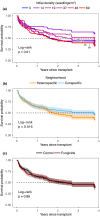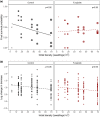Interactions with soil fungi alter density dependence and neighborhood effects in a locally abundant dipterocarp species
- PMID: 35127017
- PMCID: PMC8796921
- DOI: 10.1002/ece3.8478
Interactions with soil fungi alter density dependence and neighborhood effects in a locally abundant dipterocarp species
Abstract
Seedling recruitment can be strongly affected by the composition of nearby plant species. At the neighborhood scale (on the order of tens of meters), adult conspecifics can modify soil chemistry and the presence of host microbes (pathogens and mutualists) across their combined canopy area or rooting zones. At local or small spatial scales (on the order of one to few meters), conspecific seed or seedling density can influence the strength of intraspecific light and resource competition and also modify the density-dependent spread of natural enemies such as pathogens or invertebrate predators. Intrinsic correlation between proximity to adult conspecifics (i.e., recruitment neighborhood) and local seedling density, arising from dispersal, makes it difficult to separate the independent and interactive factors that contribute to recruitment success. Here, we present a field experiment in which we manipulated both the recruitment neighborhood and seedling density to explore how they interact to influence the growth and survival of Dryobalanops aromatica, a dominant ectomycorrhizal tree species in a Bornean tropical rainforest. First, we found that both local seedling density and recruitment neighborhood had effects on performance of D. aromatica seedlings, though the nature of these impacts varied between growth and survival. Second, we did not find strong evidence that the effect of density on seedling survival is dependent on the presence of conspecific adult trees. However, accumulation of mutualistic fungi beneath conspecifics adults does facilitate establishment of D. aromatica seedlings. In total, our results suggest that recruitment near adult conspecifics was not associated with a performance cost and may have weakly benefitted recruiting seedlings. Positive effects of conspecifics may be a factor facilitating the regional hyperabundance of this species. Synthesis: Our results provide support for the idea that dominant species in diverse forests may escape the localized recruitment suppression that limits abundance in rarer species.
Keywords: Borneo; Janzen–Connell; Lambir Hills; coexistence; ectomycorrhiza; feedbacks; fungi; natural enemies; oomycete; pathogen; population.
© 2022 The Authors. Ecology and Evolution published by John Wiley & Sons Ltd.
Conflict of interest statement
The authors declare no conflict of interest.
Figures



References
-
- Aiba, M. , & Nakashizuka, T. (2007). Variation in juvenile survival and related physiological traits among dipterocarp species co‐existing in a Bornean forest. New Phytologist, 18, 379–388.
-
- Aiken, L. S. , & West, S. G. (1991). Multiple regression: Testing and interpreting interactions. Sage.
-
- Augspurger, C. K. (1983a). Offspring recruitment around tropical trees ‐ Changes in cohort distance with time. Oikos, 40, 189–196. 10.2307/3544582 - DOI
-
- Augspurger, C. K. (1983b). Seed dispersal of the tropical tree, platypodium‐elegans, and the escape of its seedlings from fungal pathogens. Journal of Ecology, 71, 759–771.
-
- Augspurger, C. K. (1984). Seedling survival of tropical tree species ‐ Interactions of dispersal distance, light‐gaps, and pathogens. Ecology, 65, 1705–1712. 10.2307/1937766 - DOI
Associated data
LinkOut - more resources
Full Text Sources
Other Literature Sources

